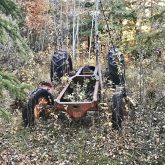I’ve got my application in to be a greeter on that new U.S./Russia space station they are planning to build about 440,000 km above the earth. But since they aren’t doing any real hiring until about 2028 I’ve got some time. (I may withdraw my name anyway. Even when I’m on a boat, I always like to be able to see shore. Being 440,000 km away from land may push my comfort level.)
Closer to home, I recently talked to Nathan Phinney who along with family members runs a 2,000-head beef-backgrounding and custom-feeding operation near Sackville, New Brunswick. He tells me they can grow grass to beat the band during the summer, but when winter sets in, it sets in. While cattle are fed under cover he says some years they have received up to 14 feet of snow. Sounds like a full time job just shovelling.
Read Also

Gentle treatments for pain in the neck
Heading toward year-end, people unknowingly tense up against the cold and busyness, causing neck pain that can often be treated with appropriate support and gentle mobility, athletic therapist Kathlyn Hossack says.
- More ‘Hart Attacks’: Would it really be so bad to have a cool day?
Then I had good talk with Francois Handfield who along with his wife Veronique Bouchard have a market garden farming operation near Mt. Tremblant, Quebec. That’s about 1.5 hours east of Ottawa or about 1.5 hours north of Montreal.
What an industrious and progressive pair of farmers! Neither had a farming background. They took agriculture at university and about 10 years ago launched a market garden in the mountainous, hilly country around Mt. Tremblant.
Francois says the pair of dreamers started out with a wheelbarrow, shovel and $500 to buy seed and other supplies. Today they produce 65 different vegetables, have a 20,000 square foot greenhouse, have some year round vegetable production, have six full time employees (20 seasonal), supply fresh produce to about 4,000 customers and gross about $800,000 in income. It’s a fully organic operation.
That’s definitely “where there is a will, there is a way” story. They had the education and the management skills and are making it work.
In southwestern Ontario, Brian Pelleboer of Wyoming, (I didn’t know we had a Wyoming in Canada) definitely has a diversified farming operation. He’s got the usual Ontario cash crops — corn, soybeans and wheat. Depending on the year he also runs anywhere from an 80 to 200 head commercial beef cow-calf herd. And, if that’s not enough, they also have a 400-head goat milking herd and are just building another barn to more than double the number of milking goats — about 900 head total.
He talks about a pragmatic synergy between the goat and cow herds. The milking goats are fed a fresh silage based Total Mixed Ration every day and what they don’t clean up is collected and fed to the cowherd. Everyone eats well. (He says sometimes the cows eat too well, he has to watch it and cut back on the ration).
Near Birtle in southwest Manitoba towards the Saskatchewan border Tyler Fulton says they had a pretty good grazing season. He’s preparing to put the cows on some cereal crop swath grazing later this fall and then move them into corn grazing come January. Replacement heifers will be moved into a 20-acre paddock and fed a higher quality ration over winter.
Down in southern Saskatchewan, near Lake Alma, near the U.S. border Ross Macdonald says despite it being a very dry growing season they had plenty of grass for their purebred and commercial beef cowherds.
He buys all his hay for a winter bale grazing program and hay is an expensive commodity in short supply this winter. He may downsize the herd this winter to match it to the hay that is available.
And speaking of water (or lack of it in many parts of Western Canada), many farmers across the west this year say they were impressed with the crop yields they did get despite the lack of growing season rainfall.
Wayne Lindwall, a long time Agriculture and Agri-Food Canada researcher, who retired a few years ago, points out much of the success of this year’s crop can be credited to conservation farming practices.
Lindwall was a pioneer in researching and promoting conservation farming measures across Western Canada over the past 30 years. Believe it or not (and he admits some people question his numbers), but he figures it takes about 2,000 tons of water to produce one ton of grain.
Using my limited math skills I figured for a 50 pound bushel of wheat or barley that works out to about 10,000 gallons of water per bushel. Cereal crop roots will travel up to 6.5 feet deep in the soil, while some tap rooted perennials can go up to 30 feet deep.
Dry areas are going to need some rain this fall and winter snow to replenish moisture so Lindwall still has the same advice to all “keep your stubble up.”
















